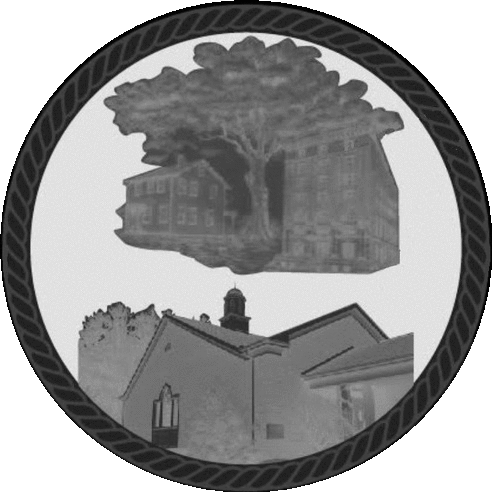
Free and Accepted Masons of Ohio
8387 Tod Ave
Boardman, Ohio 44512
(330) 729-0458
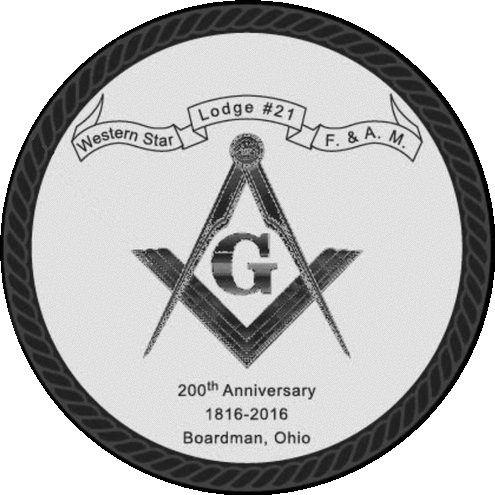
 |
Western Star Lodge #21 Free and Accepted Masons of Ohio 8387 Tod Ave Boardman, Ohio 44512 (330) 729-0458 |
 |
| Contact the WEBMASTER |
|
|
|
|
|
|
| HISTORY OF
F. & A. M. No. 21 |
|
As we thumb through the pages of history and the records of Western Star Lodge No. 21, Free and Accepted Masons, we find that the annals of the fraternal order show that its background
is intimately interwoven with the early settlement of the Western Reserve, the development of Mahoning County and the growth of Youngstown into a metropolitan area.
|
Jump to "A brief history of our area" Jump to "Masonry in the Valley" Jump to "A few items and visitors stood out in reviewing the minutes over 200 years" Jump to "A brief history of Major General Elijah Wadsworth: our first Worshipful Master" Jump to "A few more details about the founding Past Masters, the Morgan Affair and an Oak Tree" Jump to "Our years in Youngstown" Jump to "Canadian visitation with Buchanan Lodge" Jump to "Moving to Boardman (again)" Jump to "Celebrating 200 years in the Mahoning Valley" Jump to "Master's Civic Project" Jump to "The History of Sulgrave Lodge No. 696" * * * A brief history of our areaLest we forget, the area which is now Ohio was once the subject of many conflicting claims: that of Connecticut, claiming under a royal grant in her original charter 'from sea to sea', Virginia, by the London Companys charter of 1609 granted by James I to lands from Old Point Comfort 200 miles north and westward to the Pacific: France by the discoveries of Robert de la Salle and upon the treaty of Utrecht, in 1713, which made the area a part of the French province of Louisiana; claims of the Six Nations, and it may be noted, by the 'Quebec Bill', passed in British Parliament in 1774, making the Ohio River the southwestern and the Mississippi River the western boundary of Canada. These claims were ultimately resolved, and on the 14th of September, 1786, Connecticut ceded to Congress all her 'rights, title, interest, jurisdiction, and claim to the lands northwest of the Ohio, excepting the Connecticut Western Reserve:', and of this tract, jurisdictional claim was not ceded to the Untied States until May 30, 1800. On September 2, 1795 48 men who subscribed $1,200,000 for the purchase of the estimated four million acres involved formed the Connecticut Land Company. It had never been surveyed. It was here that a man who later became one of the stalwarts of Western Star Lodge Elijah Wadsworth, made his first appearance. He, with five others, Judson Canfield, James Johnson, David Waterman, Nathaniel Church and Samuel Canfield purchased 'Township One in Range Three'. They were then living in Connecticut, and sent a survey party out from Sharon, Connecticut in 1797, headed by Nathaniel Church, who wrote that 'I performed the journey on horseback with all my effects contained in my saddlebags. My men traveled on foot.' Elijah Wadsworth supplied the party with axes, chains, squares, compasses, seed, tea, pepper and ginger. 'Campfield' was the name given the township by the surveyors, as shown on their maps and notes, and is so shown in a manuscript record of the survey deposited with the records of deeds of Trumbull County. On April 15, 1800, the book shows: 'Voted that the above-named township should be called Canfield.' The name was bestowed in honor of Judson Canfield, the largest proprietor of land in the new township. Settlers moved in from New England, some making the trip over the route of the survey party through New York, New Jersey, Pennsylvania, Fort Pitt, to the mouth of the Big Beaver, thence upriver. 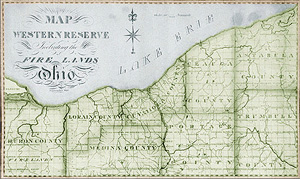 * * * Masonry in the ValleyAmong the pioneers of Canfield were those who soon wished to establish a Masonic lodge there, as they resided no less than twenty miles from any regular Lodge of Masons, and travel was either on foot or by horse. They therefore petitioned the Grand Lodge of Ohio then sitting at Chillicothe, through Eire Lodge No. 47 of Warren, (which had been created by a charter of the Grand Lodge of Connecticut at New Haven October 19. 1803, and later became Old Erie No. 3 of Ohio) for a charter to sit and work as Masons in the Village of Canfield, Trumbull County,. The petitioners were: Charles A. Boardman, Isaac Newton, Francis Dowler, Richard Fitch, Charles B. Fitch, Tryall Tanner, Lewis Hoyt, William Logan, Hervy Ripley, George Stillson, Elisha Whittlesey, Archibald Tanner, Arad Wan and Elijah Wadsworth. Pursuant to this request, John Leavitt, Master of Erie Lodge No. 47 forwarded a letter of recommendation to the Grand Lodge, and after due consideration, the Grand Lodge, by Henry Bush, Grand Master, on January 17, 1813, by dispensation established a Lodge of Ancient York masons, to be held in the town of Canfield, to be denominated the WESTERN STAR LODGE NO. 21, and appointed Elijah Wadsworth to be the first Master, Tryall Tanner to be the First Senior Warden and Isaac Newton to be the first Junior Warden. Tradition tells us, that the name Western Star was the suggestion of Elijah Wadsworth. On June 8, 1813 the brethren met at the home of Zalon Fitch, from where they next assembled at the school house to hear an address by Brother Darrow of Vienna, then returned to the Fitch house where the officers were installed by George Todd, appointed by John Leavitt, Master of Erie Lodge No. 47 for that duty. Thereafter Western Star Lodge met 'on the Thursday preceding every full moon' and continued under dispensation until a charter was obtained; the charter was presented at a meeting February 8, 1816, together with an accompanying letter of January 17, 1816 from Western Star's representative to the Grand Lodge, William W. Cotgreave. The lodge met at the Fitch House until April 28, 1814, 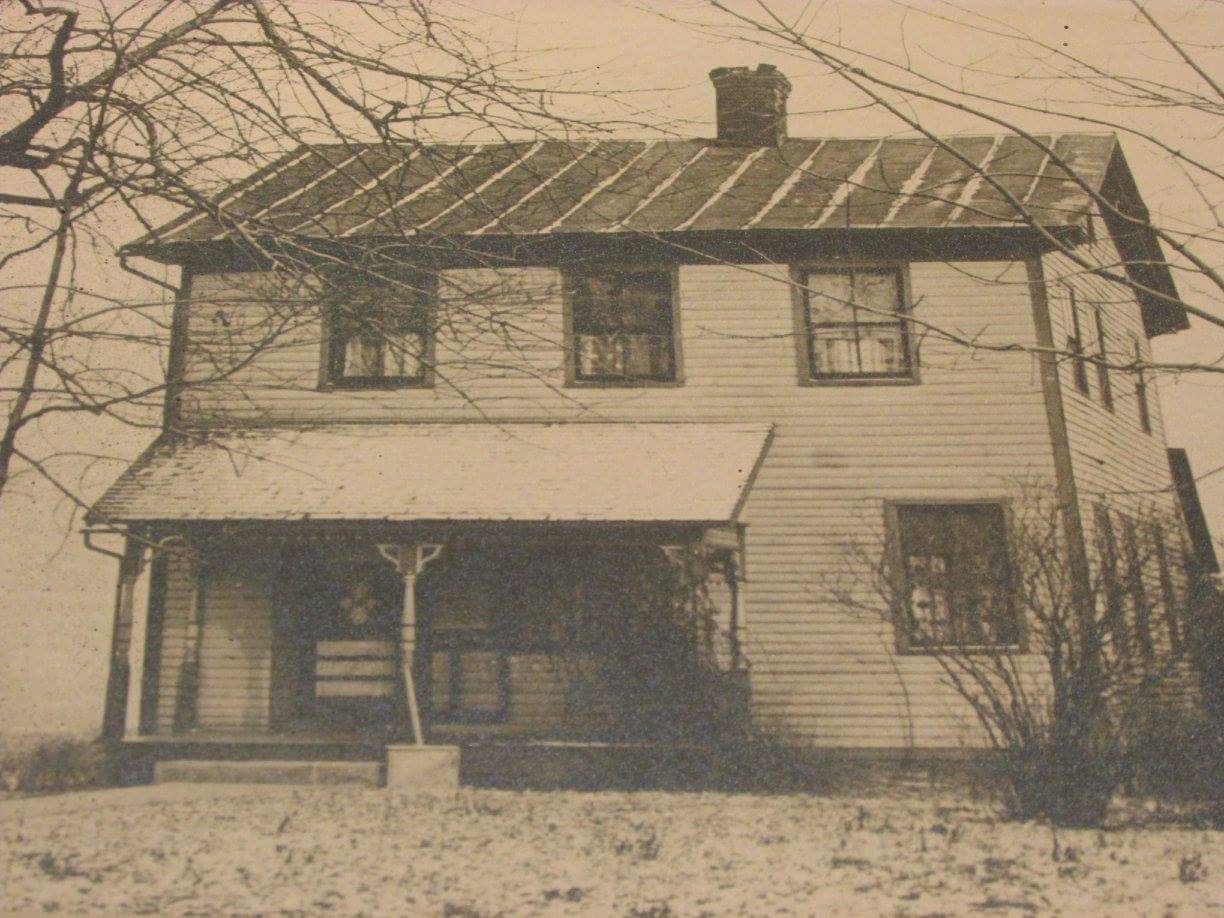 when larger quarters were needed, and arrangements were made for a room at the house of Brother Bostwick; Snippet from Eli Taylor Boughton's history (who indeed was a tailor and a PM of Western Star in 1823 & 25-27) It has been a question of interest to me for years to learn who erected and first occupied the old Clewell dwelling now owned by Mr. Isaiah Reed. In a recent conversation with Charles E. Boughton the mystery was solved. This building is the one first erected by Mr. Boughton on the corner and moved by Joseph Bostwick to its present position, but when we are unable to state. The building has undergone a number of alterations and additions. To the members of the Western Star Lodge, No. 21, of the Masonic order, the building would naturally be one of interest. The lodge, although not at first instituted within its walls, had its home for many years, perhaps most of its life, in Canfield, in the upper story of this building. In the absence of information to the contrary we suppose Mr. Boughton afterwards built all, or at least the front portion of the present drug store. The dwelling built by Mr. Boughton stood until 1882, when it was torn down to make room for the residence, on the same ground, of J.C. Kirk. in November 1820, the lodge procured a room for meeting at Brother Stoddard's house. * * * A few items and visitors stood out in reviewing the minutes over 200 yearsA visitor to Western Star in 1817, then unaware of future distinction was Jesse R. Grant of Portage Lodge No. 36, whose son; U. S. Grant was to become President of the United States. Western Star first played host to a Grand Master April 4, 1821 when the lodge was visited by John Snow, who actively took part in the work of the evening. Western Star was granted its request made December 30, 1824 that it also be allowed the privilege of meeting in Boardman, and held its first meeting there April 24, 1828. Many fine and outstanding men have served Western Star Lodge as Master in the two centuries of its existence. B. Frank Thomas, who served Western Star as Master in 1907, was elected Grand Master of Masons of Ohio for the year beginning October 1927, climaxing a distinguished career of service to the craft. * * * A brief history of Major General Elijah Wadsworth: our first Worshipful MasterA blacksmith, a gentlemen spy? a soldier, an explorer, a surveyor, a husband, a father, a leader, a sheriff, a post man, a land owner, a General, and a FreeMason. 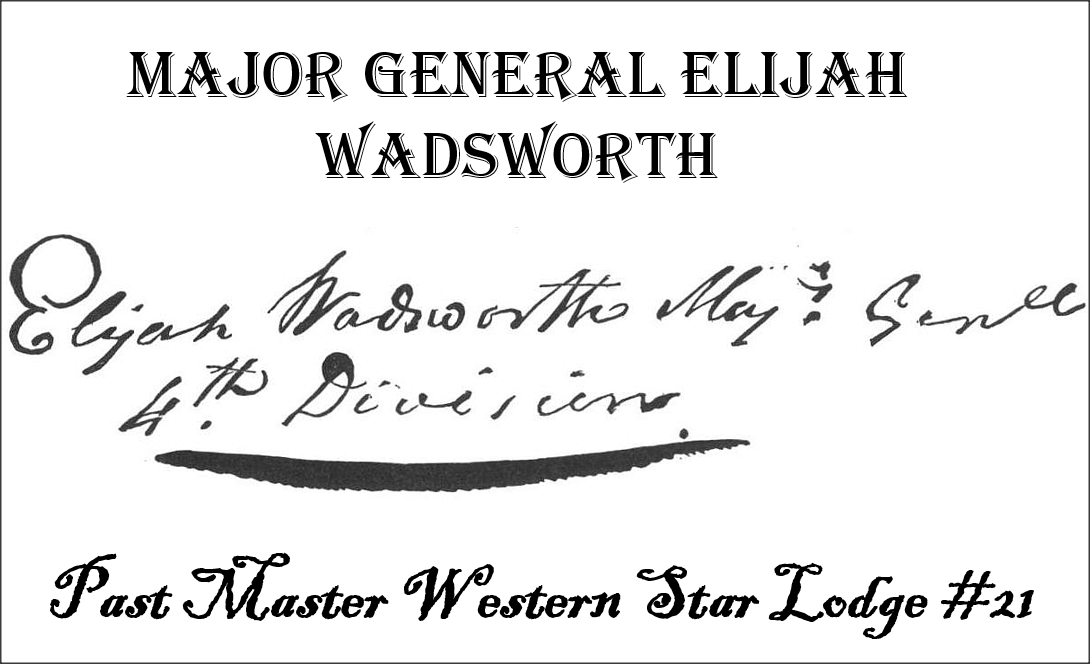 It is fitting to call attention to the unique background and qualities of the man who helped form and first served in the capacity of Master for Western Star. Elijah Wadsworth was born as Hartford, Connecticut, November 14, 1747, a lineal descendant of Captain Joseph Wadsworth who in 1687 secreted ('stole and hid') in defiance of British rule, the 1662 charter of Connecticut in the famous Charter Oak. (This charter will provide the legal precedence necessary to justify the claim of the Connecticut western reserve in Elijah's time). Of historical note Elijah built and owned a house at Litchfield Connecticut, which he sold to Chief Justice Adams; it was subsequently owned by Dr. Lyman Beecher. In this house were born Harriet Beecher Stowe and Henry Ward Beecher. In his 20's he was a black smith by trade in Litchfield Connecticut. At age 27 the Revolutionary War broke out. He is noted as being placed in command of the guard who held Major John Andre. Who was the British spy who was captured during Benedict Arnold's plot to turn West Point over to the British. Elijah helped raise and eventually became a captain the 2nd Continental Light Dragoons which amongst their several battles were known as Washington's personal bodyguard, even foiling an attempt at his kidnap by the British. They also earned the nickname 'Washingtons Eyes', likely because of their spy work. Another person in the Dragoons from the Connecticut area was Major Benjamin Tallmadge who became the spy master who ran one of the most successful spy rings of the war. The name may seem familiar to you, for Tallmadge Ohio which is just a little NE of Akron was owned and named after him. Now, secrecy in the intelligence community of the Revolutionary War was such that even Washington did not know everyone in his spy ring so no list of all of the members exist. But the connections can lead you to assume that some collaboration occurred. Two men both from prominent families in the same area of New England, who joined the same regiment immediately after the battle of Bunker hill, and after the war Tallmadge moved to the same town that Wadsworth lived in (Litchfield), and who both invested and owned land very near each other in Ohio (or at the time the Connecticut Western Reserve). I think it's likely to assume even in the absence of hard evidence Wadsworth was a spy. After his exploits in the Revolutionary War he returned to Litchfield where we can find evidence of being involved in his community. We find his name on this charter: 'That on May 9, 1789 an association was formed in Litchfield Connecticut. Signed by 35 men including the town leaders which included Benjamin Tallmadge, and, Elijah Wadsworth, The association promised to 'carry on our business, without the use of distilled spirits, as an article of refreshment, either for ourselves, or those whom we employ, and that instead thereof we will serve our workmen with wholesome food, and the common simple drinks of our own production.' Yes our Lodge was formed by a sworn prohibitionist and activist in the temperance movement' After the war he invested what monies he had into a little known company named the Connecticut Western Reserve Land Company. He purchased 1/60th share of the 3.4 million acres the reserve was made of. Which translates to over 56,000 acres or 88 square miles. Such was the investment that he did not own this all in one chunk, but rather owned portions all over the reserve, his name can be found from Conneaut in the north, Boardman in the East and to the western most edge of the reserve, the town he's named after; Wadsworth. Such was the nature of this investment that the owners were looking to sell as soon as possible to earn a return on their investment, and live off the monies. But, in order to make the land more valuable it was necessary to populate the land, as the land in a town was worth more than unpopulated fields. So the first sales were to people who were pioneers and willing to build towns and establish farms. This is what happened with the sale of land in 1813 to Daniel Dean (born in Litchfield Connecticut, where Wadsworth was from) and Oliver Durham of Vermont, these 1st settlers in this area, began clearing land in March 1814, on the east line of where Wadsworth is now, a town to be named Western Star. 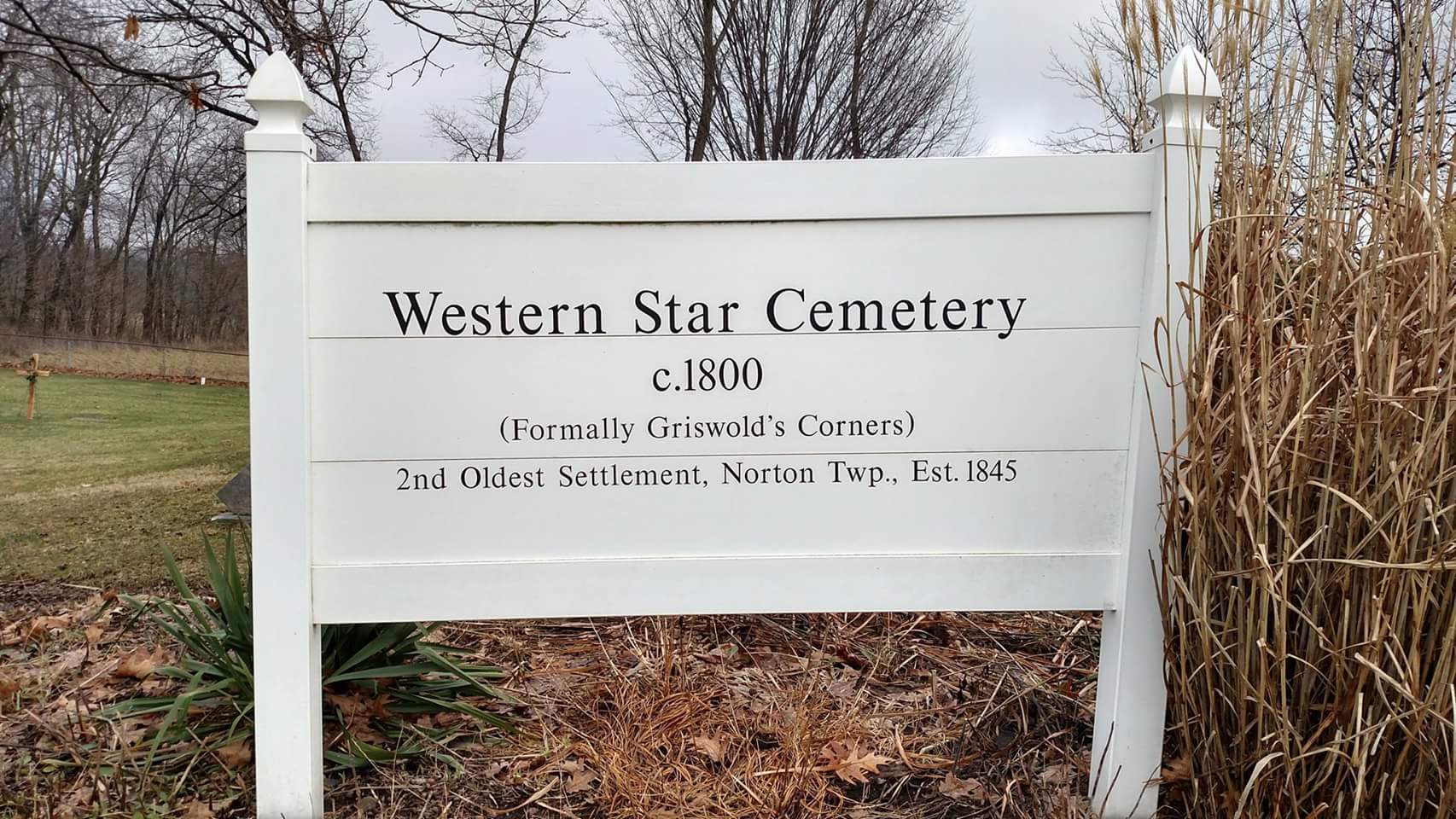 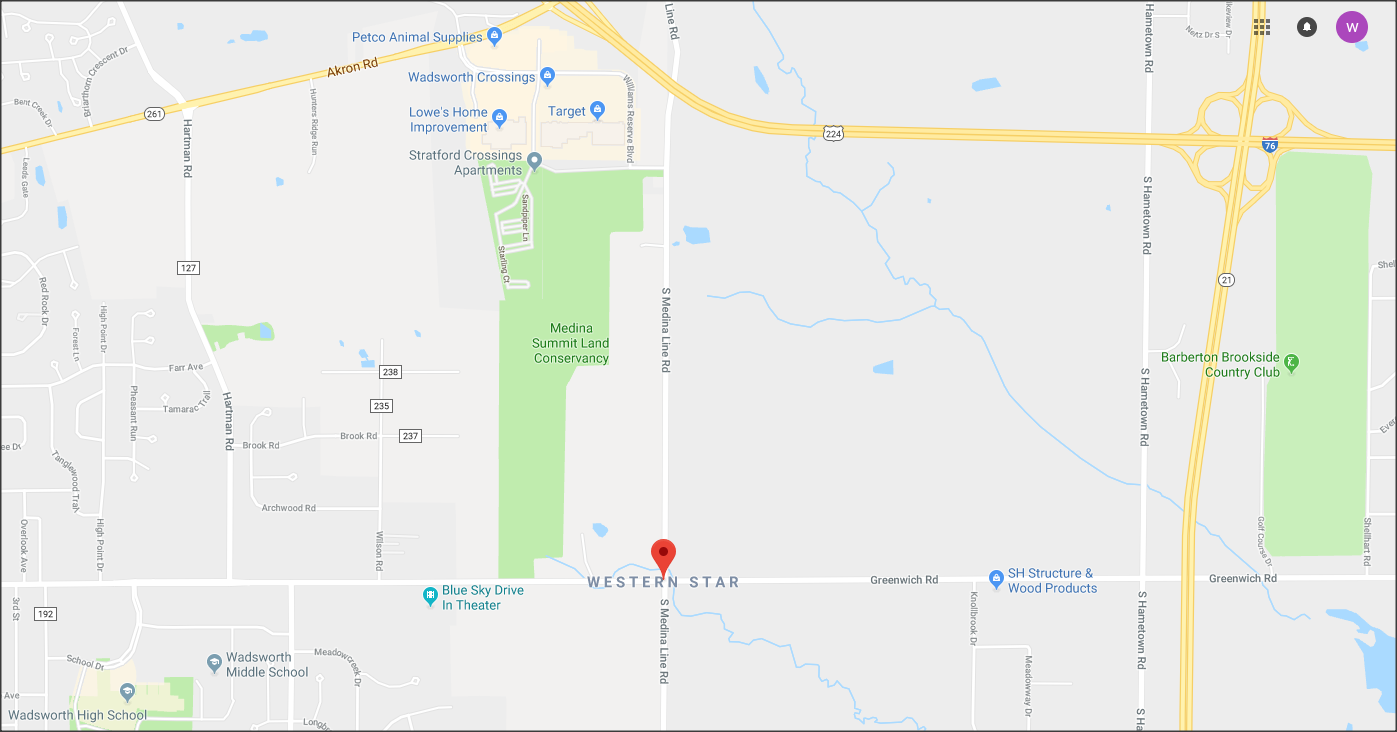 He spent the summers of 1799 and 1801 on the reserve and established the first mail route there in 1801 paying the currier 6 dollars for a 6 day round trip to Pittsburgh and back. The spring and summer of 1802 Captain Wadsworth also spent upon the Reserve. He returned each time to Connecticut by horseback as he had come, making the trip back in the fall of each year, a record of sturdy commuting that is probably unexcelled in the history of our land. On the 15th day of September 1802, he left Licthfield with his family in a wagon drawn by two horses, and leading one extra horse, and after thirty-three days on the way, arrived at Canfield October 17. He moved on to land that he owned in what was previously known as CAMPfield it was originally named by the surveyors who used it as a camp - this was before its name was changed to CANfield after Judson Canfield. (who owned the most land the town was settled on). This is the same way the city of Wadsworth got its name, because the town was established in an area where Elijah was the largest land owner. His original 1803 house still stands today just south of the Canfield village green. Though recent updates to the home have not been historically correct this is the site and portions of the original home still exist. 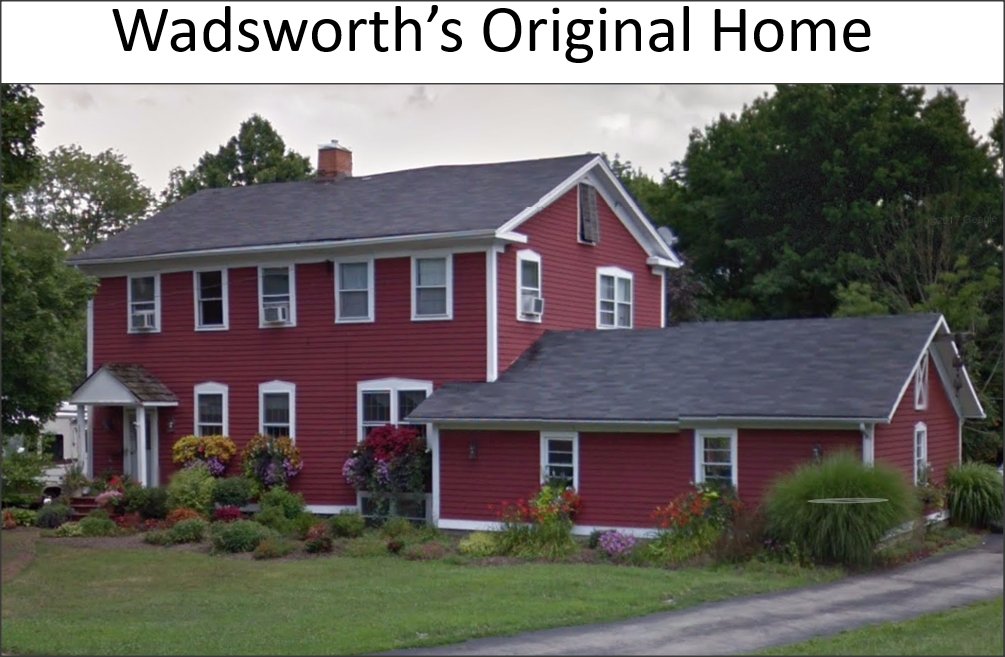
In addition to serving as postmaster at Canfield, from 1801 until his resignation in 1803 and again in 1813. He was elected Sheriff of Trumbull County at the first election after Ohio became a State, held the second Tuesday in February 1803. At the session of the Ohio legislature, 1803 to 1804, he was elected Major General of the 4th division of the Ohio Militia which embraced more than 1/3rd of the Northern part of the state. When Detroit fell to the British in 1812, Elijah with Elisha Whittlesey, one of his aides and the third Master of Western Star, under direct orders from the Secretary of War, organized a 1500 man militia from Trumbull, Columbiana & Jefferson counties to join the North West Army of William Harrison to protect the northern coast from invasion. He was 65 years old at the time. He personally footed the bill to supply his troops with supplies. He spent over $26,000 (or an equivalent of over 1/2 a million dollars today). He died December 30, 1817 aged 70 years old. His cause of death was due to complications of a stroke or 'shock of the palsy which paralyzed his left side'. 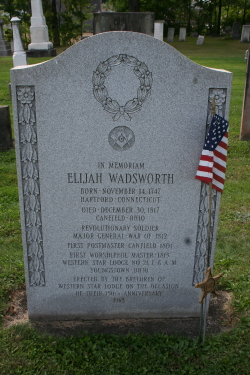 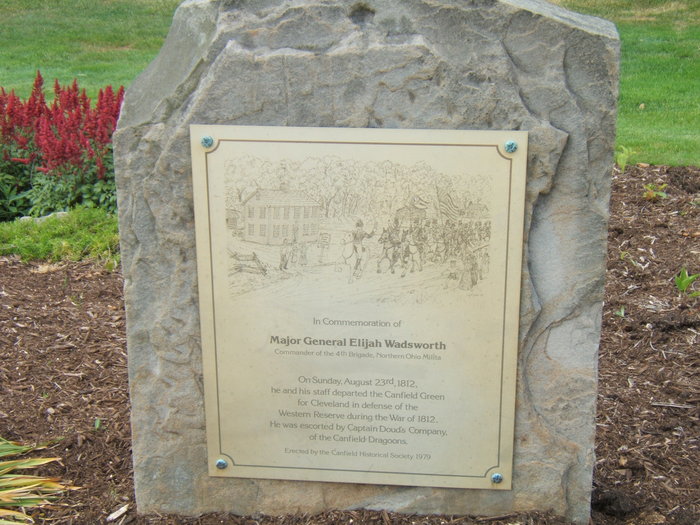 Military history says of him: Now, to the honor of Congress and the Nation, however, this judgment was discharged by an act of Congress, but not until he had been dead for years, as the act was passed March 3, 1825. * * * A few more details about the founding Past Masters, the Morgan Affair and an Oak TreeCharles A. Boardman, second Master of Western Star, serving in 1814 to 1815, was born in Connecticut in 1788, and came to Canfield as a surveyor. He resigned as Master January 19, 1815 and returned to Connecticut, to complete studies for the ministry. Here again are seen the ties between a Master of Western Star and New England history, for he was ordained in 1818 at Preston, Connecticut, the charge being delivered by the noted Dr. Lyman Beecher. He preached first at New Haven and Westport, and on August 6, 1839, was installed as pastor of the First Presbyterian Church of Youngstown, where he served until 1854, when he petitioned to be released from his chare. He went to Monroe, Wisconsin, where he resided with his son in law until his death. His body was brought to Youngstown for burial; services were held in the church July 29 of 1860. Elisha Whittlesey, third Master of Western Star, was born October 19, 1783, and came to Canfield in 1806 after having studied law in Connecticut. He was admitted to the bar at Warren, and served as prosecuting attorney until 1823. Serving in the War of 1812, he was appointed Brigade Major; in 1841 he was appointed Auditor of the Treasury for the Post Office Department by President Harrison, and again by President Lincoln in 1861, and became of national reputation. He was fatally stricken at his desk January 7, 1863. It's worth noting the name John Northrop who was WM for the first time in 1819, one of our founding members (his name is on the Charter). He held every office in the lodge, was remarkably regular in attendance, and served as master in 1819, 1820, 1828 to 1848. In 1828 when Western Star went dark following the Anti-Masonic movement caused by the Morgan Affair. Regarding the Morgan Affair, let me quote an excellent explanation written at the time by Old Erie Lodge #3 in Warren Ohio:
In such a violent environment, WB Northrop, following the example of our founding Master's family, took our Charter and hid it in an oak tree. From then on, the oak tree has stood as a symbol of Western Star. Strong and resolute.  Note the Oak tree in the background of our 100yr anniversary plate and pitcher Note the Oak tree in the background of our 100yr anniversary plate and pitcher

In 1848 WB Northrop was still active and signing in as Worshipful Master, 20 years after Western Star's last election, but this time for a newly formed Lodge in Youngstown named Mahoning Lodge. A letter was sent to the Grand Lodge of Ohio to charter this new Lodge in Youngstown. When it was revealed that Western Star had never officially closed and WB Northrup was still the acting Worshipful Master. He remained a member until 1854, when he was granted a demit. The petition for this new lodge was withdrawn and Western Star officially moved to Youngstown on November 5, 1852. * * * Our years in Youngstown:During its life in the Mahoning Valley, Western Star has noted many interesting incidents, allied with the life and times of the community.John M. Webb was the first Master Elected after this move to Youngstown; Thomas H. Wells was chosen Senior Warden. The lodge arranged with Hebron Lodge, I. O. O. F. to rent their room at $30.00 per year. In 1854 arrangements were made to rent from Messrs. Arms and Murray. On November 16, 1855 Brother B Young presented the Masonic apron of Brother James Hillman, deceased, to be placed in the lodge: His portrait was presented to the lodge in 1861, and both apron and portrait adorned the foyer at the temple on the hill. On April 7, 1854, Western Star was requested by William S. Parmalle to hold Masonic Funeral Services for Judge William Rayen. On January 13, 1863, a committee of Western Star was appointed to return the body of Past Master David McClelland, killed during the Battle of Murfreesboro, Tennessee, December 31, 1862. The body was brought home and buried with Masonic Honors March 5, 1863. On October 14, 1865, Brother James Reno was allowed to take the melodeon home for two weeks of practice. Apparently his proficiency had been questioned. In 1867 the lodge acceded to progress and voted to install gas in the hall at the best and cheapest rates, and to purchase fixtures at a cost of $112.12. Up to that time candles and oil lamps had been used. On May 27, 1868, a committee was appointed to arrange for the return of the body of Brother Ross, who lost his life at Chickamauga: this was done and the funeral held July 13th. In 1872 the Lodge leased a third story of a brick building being built opposite the Tod House, furnishings were provided by subscription and the first meeting was held there May 29, 1874. In 1902 western Star joined with other Masonic bodies in planning a new Masonic Temple; from their efforts came the Masonic Temple Company, and eventually the building of the temple on Wick Avenue or 'the temple on the hill'. In September, 1904, Masonry mourned the loss of one who had earned the title of Father of the Masonic Bodies, Dr. W. L. Buechner. He was born December 3, 1830, came to Youngstown in 1854 and rose to eminence as a physician and surgeon. For four years he was Master of Western Star, taking his demit to assist in forming Hillman Lodge, of which he was master three years; was High Priest of Youngstown Chapter for two years, was the first Eminent Commander of St. Johns Commandery, serving thus for six years, and was a noted member of the Scottish Rite, Receiving the 33rd degree. June 11, 1908, in accordance with the request of the Mahoning County Commissioners, Western Star, Hillman and Argus Lodges and St. Johns Commandery participated the laying the cornerstone of the beautiful new Mahoning County Court House. 
On February 18, 1909 the Worshipful Master represented Western Star Lodge as the Grand master made president Elect William H. Taft a mason on sight. April 5, 1909 the fulfillment of the fondest hopes of the Masonic brethren of the city was achieved when Western Star, Hillman and Argus Lodges escorted the Grand Lodge to the site of the new Masonic Temple on Wick Avenue where ceremonies were held and the cornerstone was laid by Brother A. D. Thomas, representing the Grand Master, who found the stone to be square, level and plumb. Brother F A. Hartenstein, Grand Orator, delivered an eloquent and impressive address. 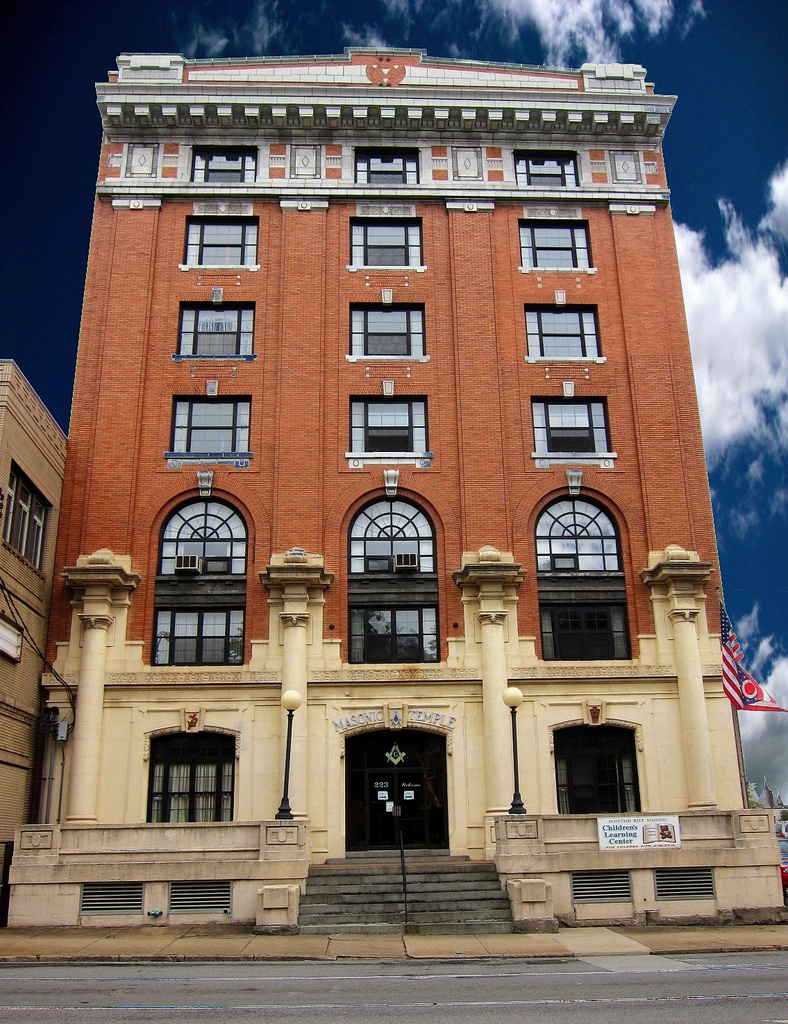
By special dispensation from the Grand Maser, Western Star held its first meeting in the new temple December 1, 1910, with Harry Schagrin as Master. The temple was duly dedicated by the Grand Lodge of Ohio December 27, 1910. On December 4, 1910 Western Star Lodge assisted the Grand Lodge in placing the Corner Stone for the First Methodist Protestant Church on W. Delason Ave. On March 8, 1912, Western Star Lodge consented to the formation of Youngstown Lodge. The new lodge to hold their meetings in the Masonic Temple in Youngstown. On July 12, 1912 WM Robert Kidston appointed the past masters and officers of Western Star Lodge a committee to have in charge the proper observance of the one - hundred anniversary of the founding of the lodge, with Bro B. Frank Thomas as chairman. On April 25, 1913, the Centennial Celebration Committee gave an interesting and spirited address on the proposed celebration of the one Hundredth anniversary of the institution of the lodge, to be observed on Friday June 6th, the anniversary falling on the Sabbath of June eight. A communication of the Lodge to extend throughout the entire day being proposed, and the neighboring sister Lodges invited to attend. A handsome souvenir having been ordered and each visiting brother to be presented with one: a buffet luncheon to be provided for the refreshment of the Craft to be given between the hours of 12 oclock, M, and 2 oclock, P.M.: a band concert: the presence of the M.W. Grand Master, and other Grand Lodge officers, a room set apart for the special use of aged brethren: addresses by prominent Masons from this State and other States: the use of the entire Temple excepting the restaurant and private apartments, and other features being assured. On Friday June 3, 1913 the Centennial Celebration was held. As a memento of the occasion a china plate appropriately embellished with Masonic emblems and engravings illustrative of historic events in the existence of the Lodge, was presented to each brother contributing to the celebration fund and to each visiting brother. A similar pitcher was presented to past masters and other important dignitaries. The plates & pitchers each bore a representation of the building at Canfield Ohio, where the Lodge was Instituted, On June 8th, 1813, which was still standing in 1913, the Oak Tree in which tradition exists our charter was secreted in during the anti-Masonic excitement, and the Masonic Temple in Youngstown.  
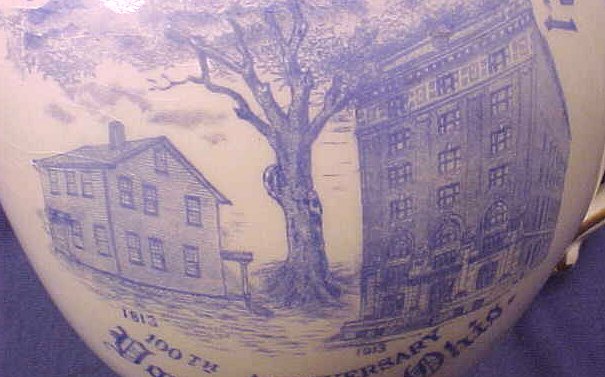 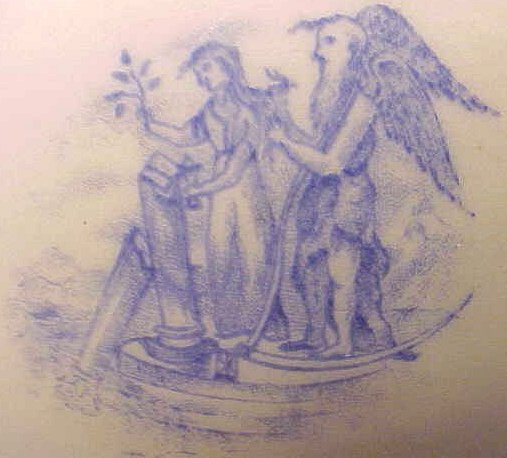
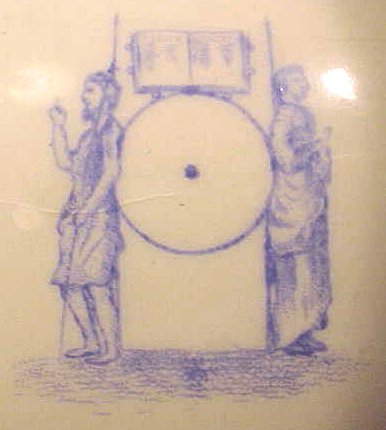 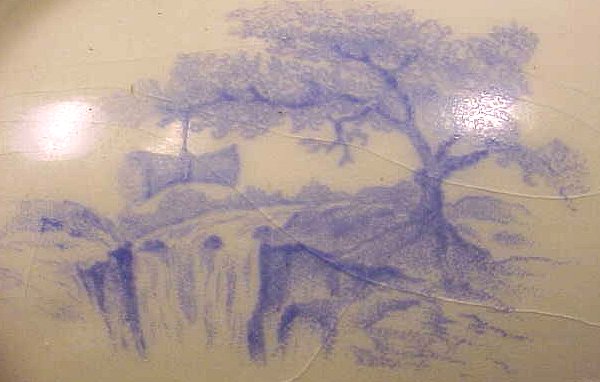
On April 17, 1914, a special communication of Western Star Lodge was held to confer the Master Mason Degree on two candidates. At this communication were present many distinguished and honored members of the craft and the total in attendance exceeded 525 brethren. Thirteen Scottish Rite masons of the 33 degree were among the visitors and in all ninety lodges were represented. One, White Hope no. 1939, of South Africa, and three lodges from Scotland were represented. There were represented in addition to these eight Grand Lodge Jurisdictions. On May 8, 1914 the bylaws of Western Star Lodge were modified changing the time of stated meetings from7:00PM to 7:30PM. The new by laws to read. 'The stated meetings of this Lodge shall be held on the second and fourth Friday of each month. The hour of assembling shall be seven thirty oclock. P.M. Eastern Standard time Special meetings may be called as provided by section 73 of the code.' On August 2, 1914 Western Star Lodge and the Grand Lodge officers participated in the laying of the corner stone of Rodef Sholom Temple on the corner of Elm and Woodbine avenues. 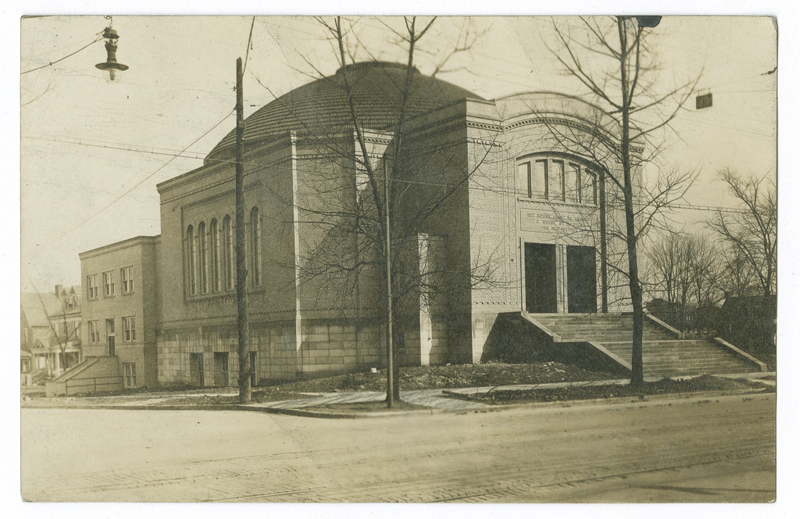
On November 25, 1914 The Lodge directed the secretary to have a telephone installed in the secretarys office. During WW I Western Star Lodge supported the brethren on active duty with the armed forces of the United States by Purchasing tobacco and other gift items, sending Christmas gift baskets, buying liberty bonds and purchasing a service flag. A committee of correspondence was established to write the service men. During, and just after, WW I the Masonic Fraternity was flooded with petitions for member ship. In 1918 Western Star raised 106 men to the sublime degree of MM and in 1919 203 and in 1920 229 men were raised. On March 8, 1918 the Grand Lodge issued a Cautionary letter reminding the lodges that proper procedures must be followed in conferring the three degrees. No short cuts would be allowed in the balloting and conferral sequence. As many men were displaced around the country due to military necessity many men received their degrees in lodges near where they were stationed. The Grand Master released instructions that when this was required the original lodge must make a written request of the local lodge to confer the degrees. The local lodge was to communicate the status of the candidate as he received each degree. The Grand Master further directed that the home lodge should compensate the lodge performing courtesy work for any expenses incurred. On November 5 1920 the Past Masters of the Lodge assumed the officers stations for Past Masters Night. WB E. M. Faust raised his son, Homer Faust, to the sublime degree of Master Mason. There were over 600 Masons present for the annual Past Masters Night. On November 12, 1920 Western Star Lodge consented to the formation of a new lodge to be named William Farr lodge to be held in Girard. On May 27, 1921 Western Star Lodge consented to the formation of a new lodge to be named St. Albans, their meetings to be held in the Youngstown Masonic Temple. On July 17, 1921 Western Star Lodge assisted the Grand Lodge of Ohio in laying the corner stone for the Belmont Ave M. E. Church. 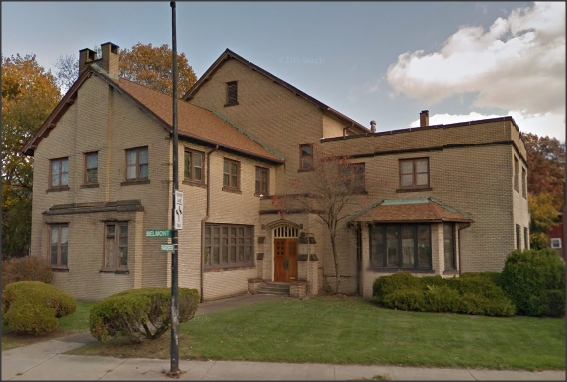
On July 20, 1924 Western Star Lodge assisted the Grand Lodge of Ohio in laying the cornerstone for the Mahoning County Tuberculosis Sanitarium. RWB B. Frank Thomas, past master of Western Star Lodge, Sr. Grand Deacon of the Grand Lodge of Ohio, represented the MW Grand Master of Ohio. 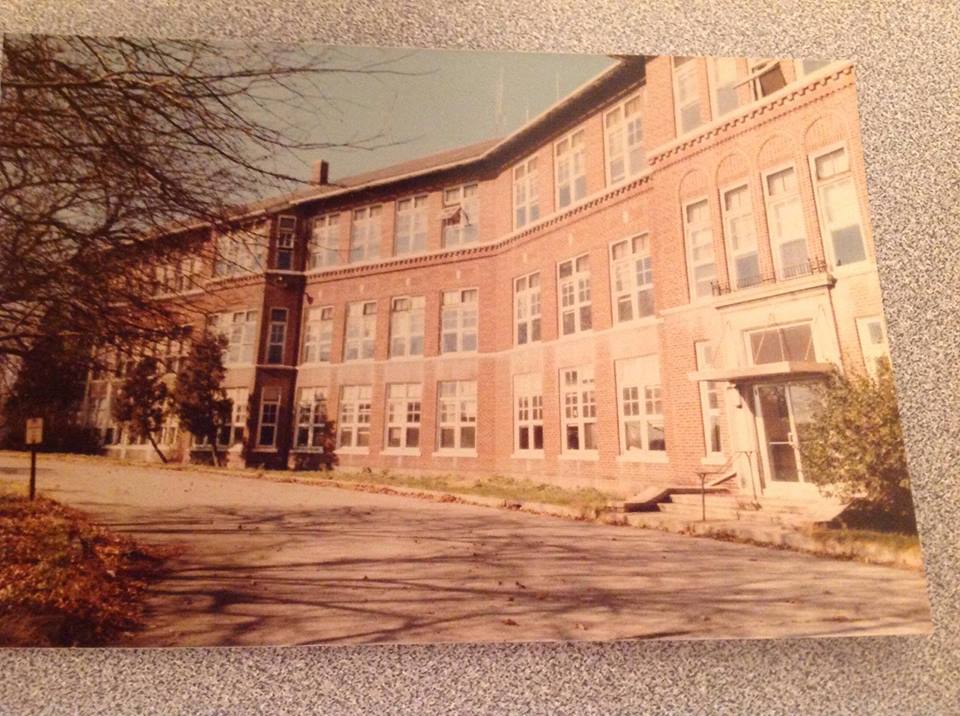
Sept 7, 1924 Cornerstone Mahoning Avenue Methodist Church. 
Feb 13, 1925 correspondence about starting a chapter of De Molay On April 23, 1925 Western Star Lodge consented to the formation of a new lodge to be named Sulgrave, their meetings to be held in the Youngstown Masonic Temple. Jump to "The History of Sulgrave Lodge No. 696" August 2, 1925 cornerstone N. H. Chaney High School. 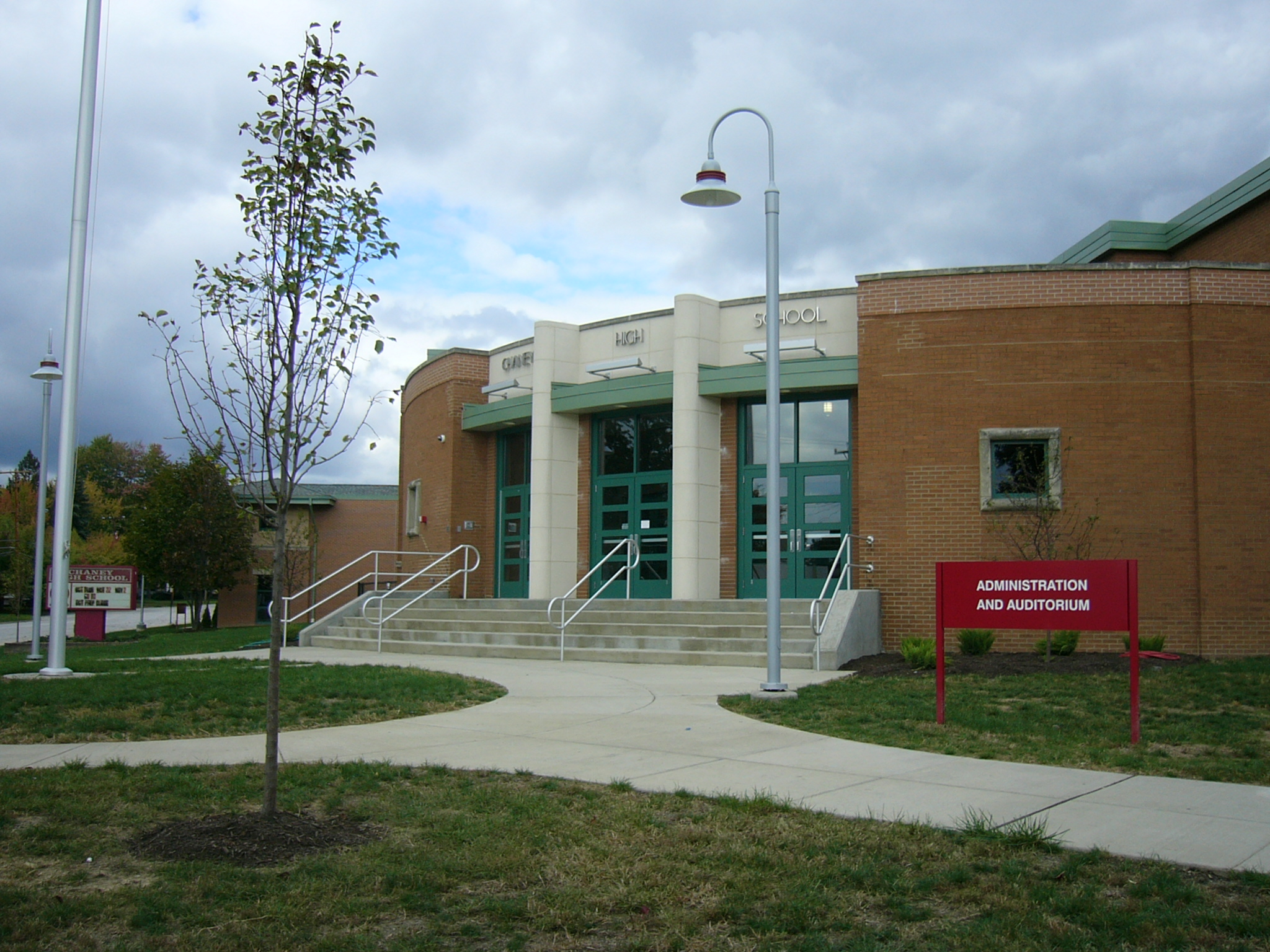
* * * Canadian visitation with Buchanan Lodge:April 29th 1939 Western Star visited Buchanan Lodge #550 in Hamiliton Ontario Canada for the first time - this biennial visit where our lodge visits theirs every 2 years and on the off years they come visit us has been continuous since 1939. 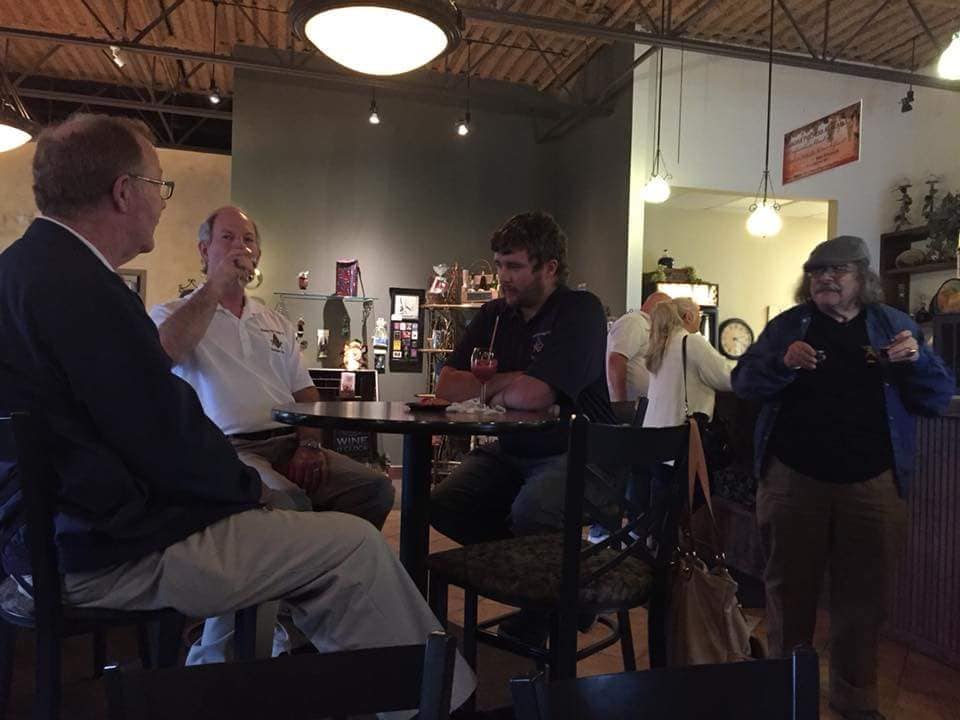
August 13, 1948 Western Star Lodge grants an Honorary Membership to MW Grand Master Raymond A. Younger. August 25, 1950 Western Star Lodge grants an honorary membership to MW Grand Master William R. Pringl. May 23, 1952 WB Robert L. Troescher is appointed the Grand Representative of the Grand Lodge of Nebraska A.F. & A. M., to the Grand Lodge of Ohio. January 8, 1954 with the permission of the Grand master, Brother Isaac Thomas, Tyler for 32 years, is granted the title of Honorary Past master of Western Star Lodge. June 24, 1960, Western Star Lodge approves a request for a dispensation to form a new lodge in North Jackson, to be named Meander Lodge. October 28, 1960, Western Star Lodge approves a request for a dispensation to form a new lodge in Poland to be named Poland Lodge. As part of the 150th anniversary of Western Star Lodge, the gravestone for the first Master of Western Star Lodge, Elijah Wadsworth, was replaced in Canfield Cemetery. 
For the next thirty years, 1960 to 1990, the Lodge functioned in peace and harmony. Conducting stated meetings on the second and third Fridays of the Month and conferring degrees on the remaining Fridays. Some people would view this as being in a 'stuck in a Rut' If that is the case what a rut to be stuck in! While some activities occurred on an annual basis, all degrees and lodge activities were conducted at the highest level. Crowds of over one thousand people attended the picnics. The annual observance of St. John's day drew hundreds of Masons. All inspections received the highest marks possible from the Inspecting officer and Grand Lodge. In addition to the regular Lodge activities, Western Star held picnics for all members and guests, sponsored trips to the Ball Games in Cleveland, trips to the Ice Follies, frequent trips to Pittsburgh to ride the tour boats, held annual ladies nights, sponsored a Golf Outing which supports Special Olympics, and observed St. John's Day. In addition to the Grand Lodge Charities, Western Star supported School Safety Patrol program, Christmas Seals, TB sanitarium Building fund, The March of Dimes, Red Cross, The Society for Crippled Children, Animal Charity League, Easter Seals, YMCA Building Fund, purchased Circus tickets for needy children and, started a Scholarship Fund for Western Star members and families. On Labor Day, September 1, 1969, Western Star added to their list of activities by hosting the annual outdoor Master Mason degree. On this occasion there were over 1,670 Masons present representing nineteen states and five foreign countries, Scotland, Mexico, Japan, Germany and, Italy. September 26, 1976 Western Star joined with the officers of the Grand Lodge in the Corner Stone Rededication ceremony for the Foster Memorial Church. Western Star had performed the dedication ceremony for the Corner Stone on September 20, 1925. 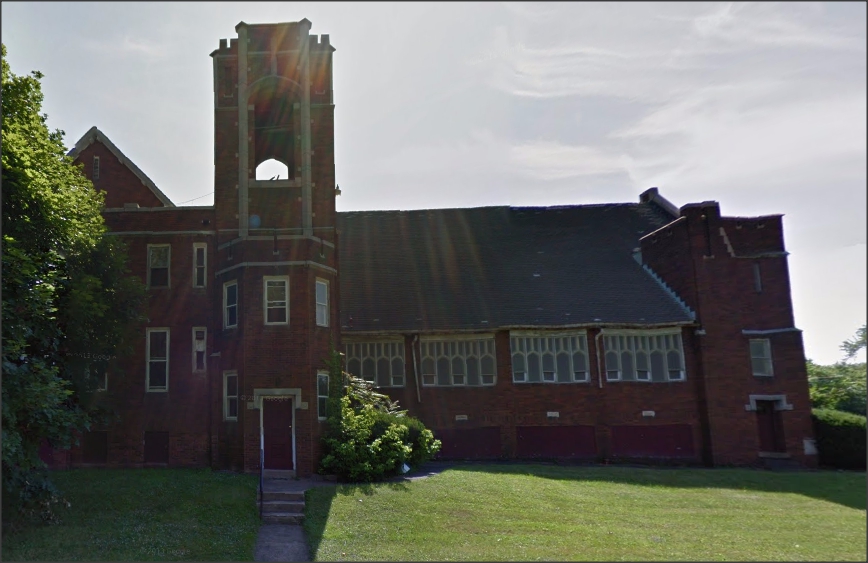
In December 1970 Brother Warren A. Steel transferred the duties of Secretary of Western Star Lodge to Worshipful Brother Dan B. Jones JR. Brother Steel served as seventeen years as Assistant Secretary with Worshipful Brother Dan B Jones. HE then severed as Secretary from 1946 thru 1970. In total Brother Steel served as Secretary or Assistant secretary for forty years. He was the assistant of W.B. Brother Dan B. Jones and was replaced as Secretary by WB Jones son, W.B. Dan B. Jones Jr On February 14, 1975 W.B. Dan B. Jones Jr. presented Western Star Lodge an Altar Bible in memory of his father W.B. Dan B. Jones. On April 24, 1976 Brother Clyde L. Crawford received his Seventy Five Year service pin. It was noted that this was the first 75-year pin presented in the 24th Masonic District. Br. Crawford was ninety-eight years old at this time. On November 19, 1976 Western Star Lodge was honored to have the Grand Master of Masons in Ohio, Most Worshipful Charles S. Ward install the officers. W.B. Bodine was installed as Worshipful Master of Western Star Lodge. On May 7, 1977 W.B. Bodine directed the Lodge in performing the Table Lodge Ceremony. This joyous celebration continues to be performed every few years in Western Star Lodge. On April 29, 1978 the Lodge traveled to the George Washington Memorial Lodge in Alexander Va. The Lodge conferred the Fellow Craft degree on two candidates at this historic site. June 23, 1978 saw the appointment of a new chairman of the sick and visitation committee, Br. Eugene Woodworth. . Br. Woodworth held that position for over 30 years. The Fonderlac Country Club was the site of the first Western Star Golf Outing. The proceeds of the outing were donated to Special Olympics. This outing was held on the first Saturday in October. The Western Star Golf Outing supported Special Olympics for 30 years! On November 11, 1986 Most Worshipful Brother Royal C. Scofield opened a secession of the Grand Lodge of Ohio, in the Temple in Youngstown and installed RW Brother Jack A Morgan as a District Deputy Grand Master. RW Morgan was the first member of Western Star Lodge to be appointed as a District Deputy in forty four years. The 175 anniversary of Western Star Lodge # 21 F. & A. M was held on the Weekend of May 14 and 15, 1988. On Saturday members of the lodge, family members and friends gathered at the Stambaugh Auditorium. They enjoyed an orchestra concert, stage show and dancing. The re-consecration ceremony was conduced on Sunday at 2:30PM. The Grand Lodge Officers led by Most Worshipful Brother George O Braatz conducted the ceremony. Right Worshipful Brother H. Ray Evans made an unplanned visit to Western Star on Friday January 24, 1992. RWB Evans was in town to attend a meeting on Saturday saw the lights on in the Masonic Temple and decided to drop in. This was a stated meeting of the lodge and the occasion for a Fellow Craft exam. RWB Evans thanked the Lodge for the courtesies extended to him and congratulated Western Star Lodge on their Dress (White tie and Tales for officers) and the dignity and decorum associated with conducting a stated meeting. He stated that 'This is Masonry as it should be'. RWB Evans was so impressed with his visit that he included this chance meeting in his address to the Grand Lodge of Ohio in his Grand Masters Report. On October 22, 1993 Western Star received the unique honor of hosting the official meeting for purpose of Masonic Dialogue between the Grand Lodge of Ohio and the Grand Lodge of Yugoslavia. Most Worshipful Brother Royal C. Scofield, Right Worshipful James Halen and Right Worshipful Brother Paul J. Belus represented the Grand Lodge of Ohio. The Grand Lodge of Yugoslavia was represented by Brothers David Vuich, U.S. Representative Grand Lodge of Yugoslavia, Brother Milan Markovich, Sovereign Grand Commander Ancient Accepted Scottish Rite of Yugoslavia, Worshipful Brother Draban Tanasich, Grand Master of Yugoslavia. On Friday March 29, 1996 History was again made in Western Star Lodge as members of Covenant and Rising Sun Lodges, Prince Hall Masonry were welcomed and shared in the conferring of the Entered Apprentice Degree. This was the first meeting in the Youngstown area between members of the Grand Lodge of Ohio and the Prince Hall Grand Lodge of Ohio. * * * Moving to Boardman (again):On January 10, 1997 a chain of events was initiated that resulted in Western Star moving form the 'Temple on the Hill' to a new temple in Boardman after a period of over ninety years. Much of the Lodge activities over the next years were directed to the planning and executing of this move. The whole process was started when W.B. Gregory B. Smith offered to provide a parcel of land in Boardman for a new Temple. After much research and discussion Western Star voted to build a new Temple in Boardman on June 13, 1997. The formal ground breaking ceremony for the new Temple took place on November 15, 1998 at 2:00 PM. 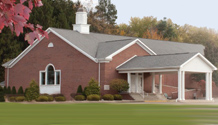
The members of the Grand Lodge of Ohio placed the Cornerstone April 18, 1999. The minutes of that meeting are included here.
The first meeting was held in the new Temple on September 5, 2001 and the Lodge room was dedicated by Most Worshipful Brother Thomas E. Reynolds, Grand Master of Masons in Ohio on April 20, 2002. On April 27, 2002 Western Star had the Honor to be the host lodge for the first Grand Masters Class in Ohio as state wide some 8,000 received light in masonry. Western Star conferred the Entered Apprentice degree on 506 candidates including 34 from Western Star Lodge. The minutes of this historic meeting are included below.
On March 1, 2003, Western Star again took part in a Grand Masters one day class by conferring the Fellow Craft Degree. There were 3,035 new members state wide, 197 in the local area including seven from Western Star Lodge. The latest Grand Masters Class was held on April 9 2005 and Western Star again functioned as the host lodge and conferred the Entered Apprentice degree. There were 3,000 candidates state wide including six from Western Star Lodge. In November of 2004 two past masters of Western Star Lodge, WB Tad Fithian and Thomas Kidd, formed a service club to provide breakfast and dinners to the lodge and community. They selected the name Elijahs Diner to honor the first Master of Western Star Lodge Elijah Wadsworth. A breakfast, open to all, is served on the second Saturday of the Month at a nominal charge. The first breakfast was on November 13, 2004 and served fewer than twenty people. The latest Breakfast served over one hundred and ten. Elijahs Diner has expanded to provide Dinners for the Lodge and District Awards Nights and running a booth at local craft fares. As a historical side note, for over a century the Fellow Craft team was paid for their labor with cigars. The minutes show the lodge purchasing at least one box of cigars each month. This process slowed down during the 1970 and stopped in the mid 1980s as the effects of smoking become better understood. Now it is illegal to smoke with in twenty feet of the Lodge Building! * * * Celebrating 200 years in the Mahoning Valley:On Saturday April 16th, 2016 the 200th year reconsecration ceremony was performed by the Grand Lodge Officers. A catered lunch was held after the ceremony and entertainment followed by Beyond Broadway. There was a history room set up where the Lodge displayed many of it's historical artifacts including a 'Master's carpet', the minutes from 1816, Elijah Wadsworth's sword and many other amazing items. All attendees recieved a Western Star 200 year challenge coin. After the activities at the Lodge the members retired to Elijah Wadsworth's grave site to place a Masonic Wreath it was attended by the Elijah Wadsworth Chapter of the Daughters of the American Revolution. Colors were presented by the Warren Chapter of DeMolay accompanied by a bag pipe procession. 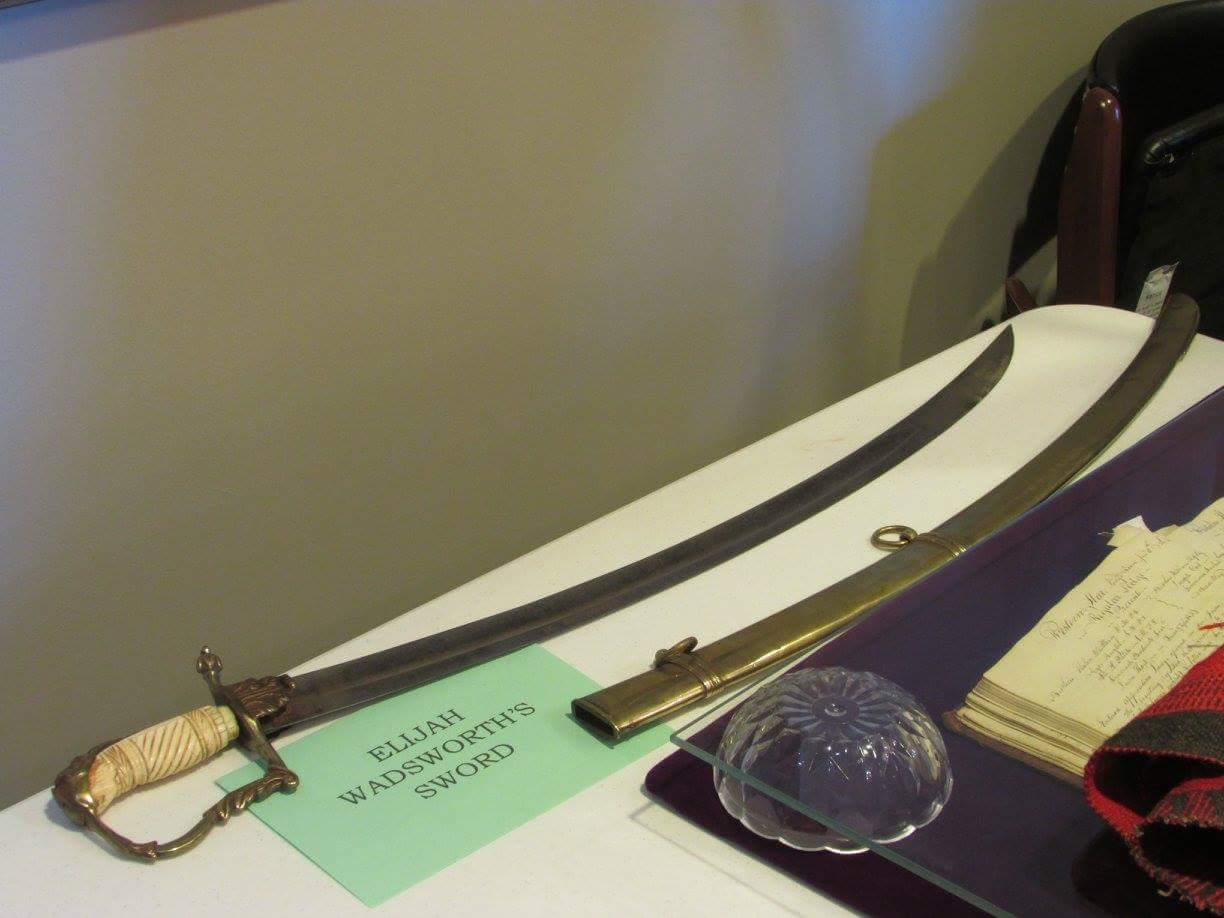 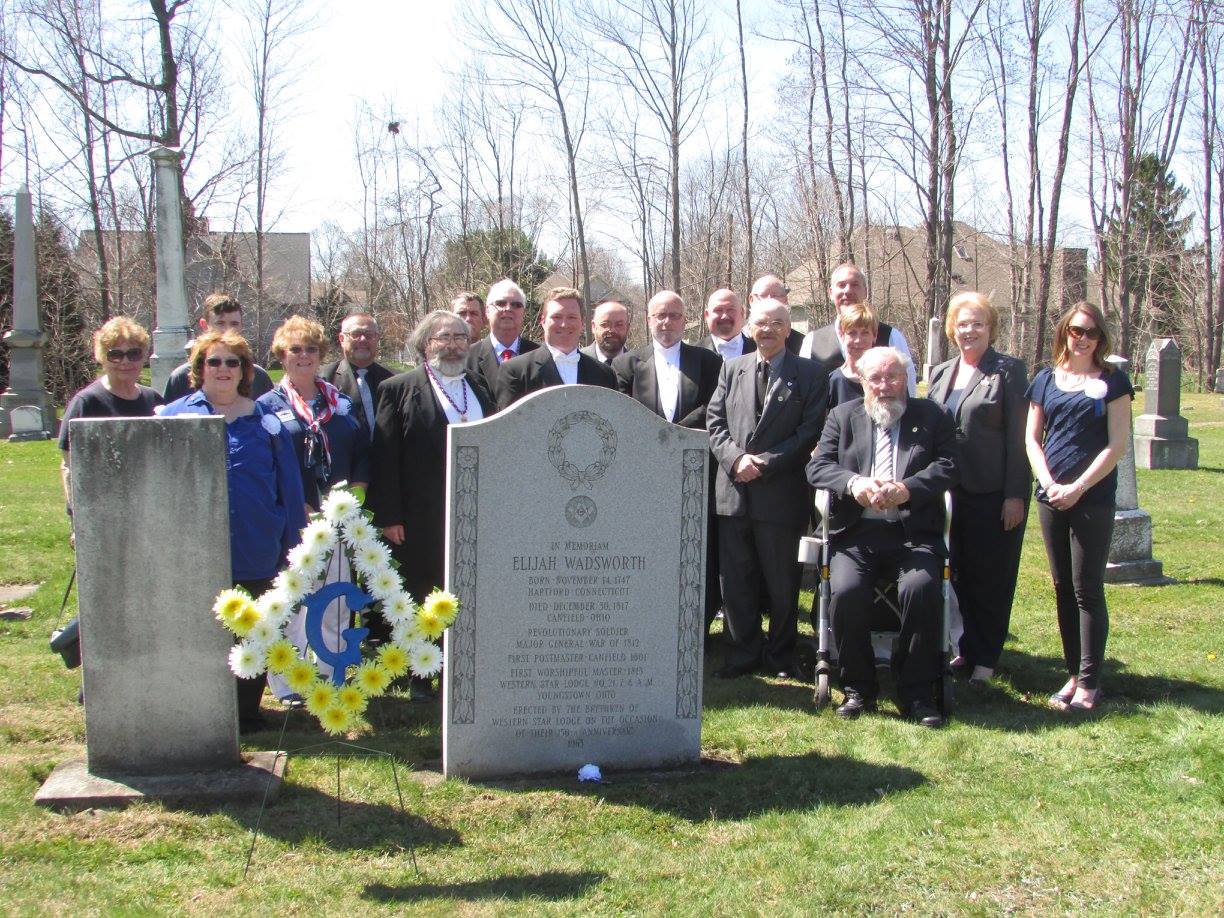 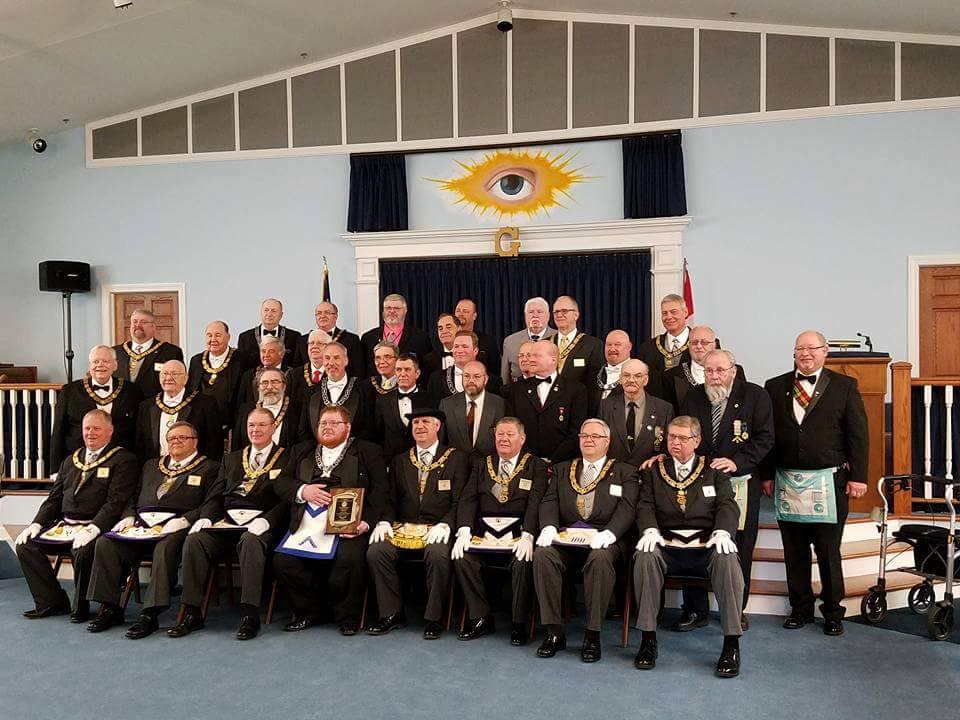
* * * Master's Civic Project:We continue to write our history! In 2017 we began a "Master's civic project" and that year purchased a new bite suit for our local K9 unit. 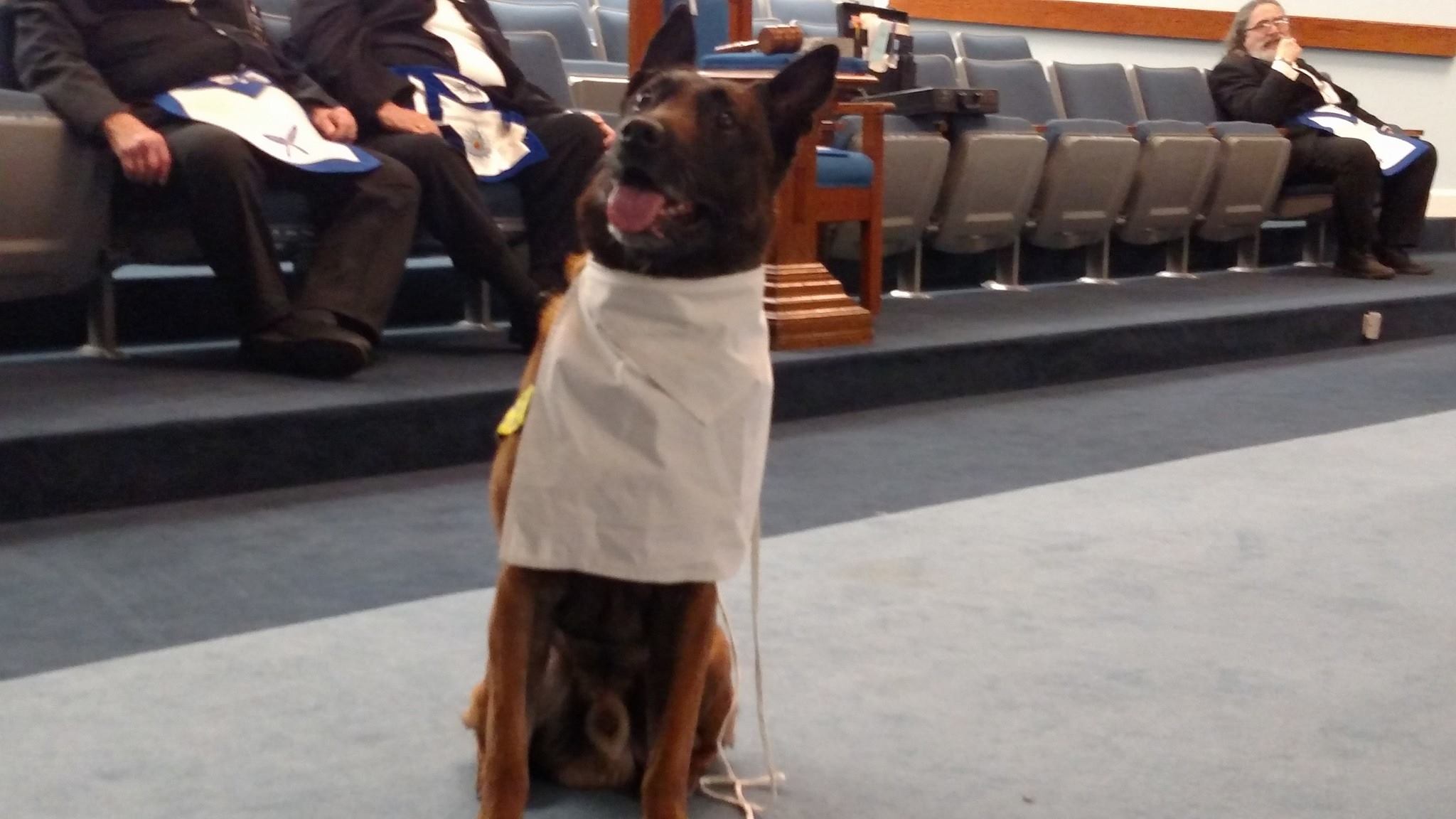
In 2018 we purchased a new radio for the Mahoning County Haz Mat Team 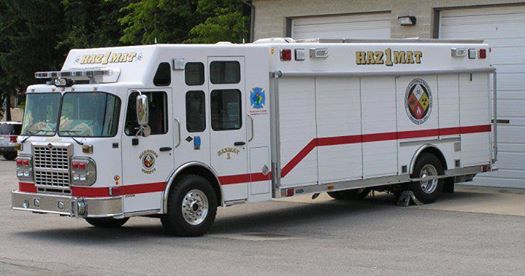
In 2019 we purchased and assembled 100 gift bags that included coloring books and crayons and assorted toys and 40 stuffed bears that said "freemasons care" and donated them to Children's Hospital in Boardman 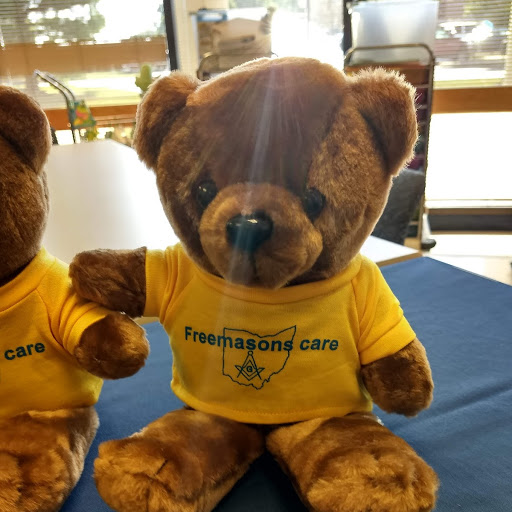 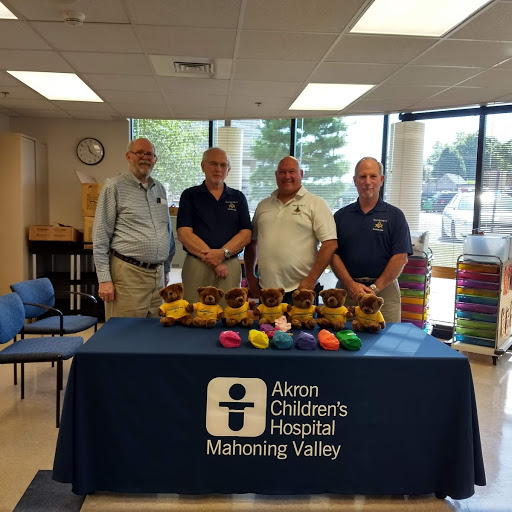
* * * The History of Sulgrave Lodge No. 696 F.& A.M.:On March 17th 2015 the Brothers of Sulgrave Lodge #696 officially merged with Western Star.
In 1924, there existed a growing need to unite unaffiliated Master Masons in the Youngstown, Ohio area into a haven of brotherhood. These brethren emanated from many jurisdictions, including a group from Scotland, and hoped to establish a lodge embodying the spirit of true Masonic Friendship as their motivating ideal. With this aim paramount, groundwork for the formation of a new Blue Lodge was instituted. On Thursday, December 11, 1924, the first meeting, for this specific purpose, was called to order by Worshipful Brother Andrew Lawton of Western Star Lodge No. 21, F.& A.M., in the Masonic Temple, Youngstown, Ohio. Worshipful Brother Newton Bender, Past Master of St. Albans Lodge No. 677, was unanimously designated to become Worshipful Master. Name Selected: A meeting was held to discuss and select a suitable name for the proposed Lodge. The committee, consisting of Brothers Ralph S. Gildart, J.C. Allison, and F.I. Sloane, on December 20, 1924, recommended the following names: Martel, Sulgrave, Fidelity, Covenant, and Constellation. The Brethren then suggested, in addition, Robert Burns, Acacia, Parian, Temple, Social, Haven, and Compass. Sulgrave, the venerable ancestral home of the Washington family, was selected and adopted as the name of the Lodge. Petition For Dispensation On January 15, 1925, upon motion duly put and carried, it was decided that the closing date for signing the Petition for Dispensation would be set for April 10, 1925; however this date was later extended to April 23rd. Application for the Consent from the various Lodges holding concurrent jurisdiction was readily forthcoming from the following: Western Star No. 21, Hillman No. 481, Argus No. 545, Youngstown No. 615, William Farr No. 672, and St. Albans No. 677. The petition for Dispensation, accompanied by the proper Forms of Consent, and containing the signatures of 156 Master Masons, was forwarded on April 23, 1925, to the Grand Lodge of Ohio. On May 7, 1925, the Dispensation, granted by Most Worshipful Brother James B. Ruhl, Grand Master of Masons, was read to the Brethren. First Meeting Held A Stated Meeting of Sulgrave Lodge, Under Dispensation, was held an May 14, 1925. Worshipful Master Bender presiding. The first item of business was the report of the Committee on Constitution and By-Laws, and is contained in our original minutes as follows:
The second item of business was the receipt of 18 petitions for degrees. Of this group, William P. Starr headed the List. The obligations of the Lodge were ordered paid and the first Stated Meeting of Sulgrave, U.D., was closed in due form and harmony. Charter Granted At the regular annual Convocation of Grand Lodge on October 22, 1925, a Charter was granted to Sulgrave Lodge No. 696 F.& A.M. On November 5, 1925, at a Special Meeting, the Lodge was duly constituted and consecrated. Right Worshipful Brother B. Frank Thomas represented the Grand Master, assisted by Deputy Grand Master Brother Thomas Douglas, Brother Andrew Lawton acted as Grand Marshal. The officers of Sulgrave Lodge were installed upon this occasion as follows: Worshipful Master, Newton Bender; Senior Warden, Robert I. Linton; Junior Warden, Claud J. Johnson; Treasurer, Frank R. Smedley; Secretary, Orson W. Abbey; Senior Deacon, J.C. Allison; Junior Deacon, Ralph s. Gildart; Chaplain, George L. Ford; Senior Steward, Walter A. Simpson; Junior Steward, Harry Burk; Tyler, Peter Mallon. Historical Highlights: Using 100-year-old costumes and equipment, Past Masters of Jerusalem lodge No. 19 of Hartford, Ohio, presented an unusual and colorful Master Mason on October 4, 1927. At this time, they exemplified the work in due and ancient form before 344 Brethren. Worshipful Brother James C. Millard was the first member raised under the Sulgrave Charter to be elected Master of the Lodge. In 1936, Worshipful Brother Philip L. Jones server as one of the youngest Masters in the State of Ohio. In 1968, he was President of the Mahoning National Bank of Youngstown, Ohio. The Custom of presenting a Masonic lapel pin to each member raised to the Master Mason Degree was instituted in 1940. Educational meetings, originating in 1942, proved inspirational and successful and are now being used extensively throughout the State. Lodge membership doubled during the years of World War II 1941-1945 Worshipful Master Harry G. Hoffmaster raised 100 candidates during the year 1946. A long-remembered Sulgrave affair was the Pittsburgh visitation in 1946 when 585 Master Masons were present. The raising of six Blice brothers in one class, unusual in the annals of Masonry, occurred in 1947. This meeting was addressed by the use of a wire recording by Worshipful Master Michael P. Sano in absentia. In 1953 Sulgrave Lodge traveled to Alexandria, Va., and raised Richard Morgan, son of our W.M., J.H. Morgan Bro. James Ferguson served as Grand Hight priest of the Grand Lodge of Royal Arch Masons in 1963 Worshipful Brother Jerome Spillman honored with York Cross of Honor In 1964, Sulgrave Lodge traveled to Patapsco Lodge No. 183 in Baltimore, Md., on the occasion of their 75th Anniversary. On September 7, 1964, Sulgrave Lodge was the Host Lodge for the Annual Outdoor Meeting held in Lisbon, Ohio, on the Lynn Riddle farm on Labor Day morning. At this meeting Worshipful Brother Robert Mason was raised. Sulgrave Degree Team was asked to perform degree work for 3 consecutive years. Annual Ladies' Night began on May 31, 1966 W. Brother Frank R. Smedley was presented his 75-year pin in 1969. Most Worshipful Brother Royal C. Scofield of Sebring, Ohio, made first Honorary Member of Sulgrave Lodge in 1971. On October 29, 1974 David Stuart presented a gavel to Sulgrave Lodge and one to the Worshipful Master. The gavels were made from the wood of a walnut tree at Sulgrave Manor in England. The altar Bible was presented to Sulgrave Lodge in 1974 by Mrs. Joseph Eperjesi in memory of her late husband, Bro. Joseph Eperjesi. Sulgrave Manor: Ancestral Home of George Washington. 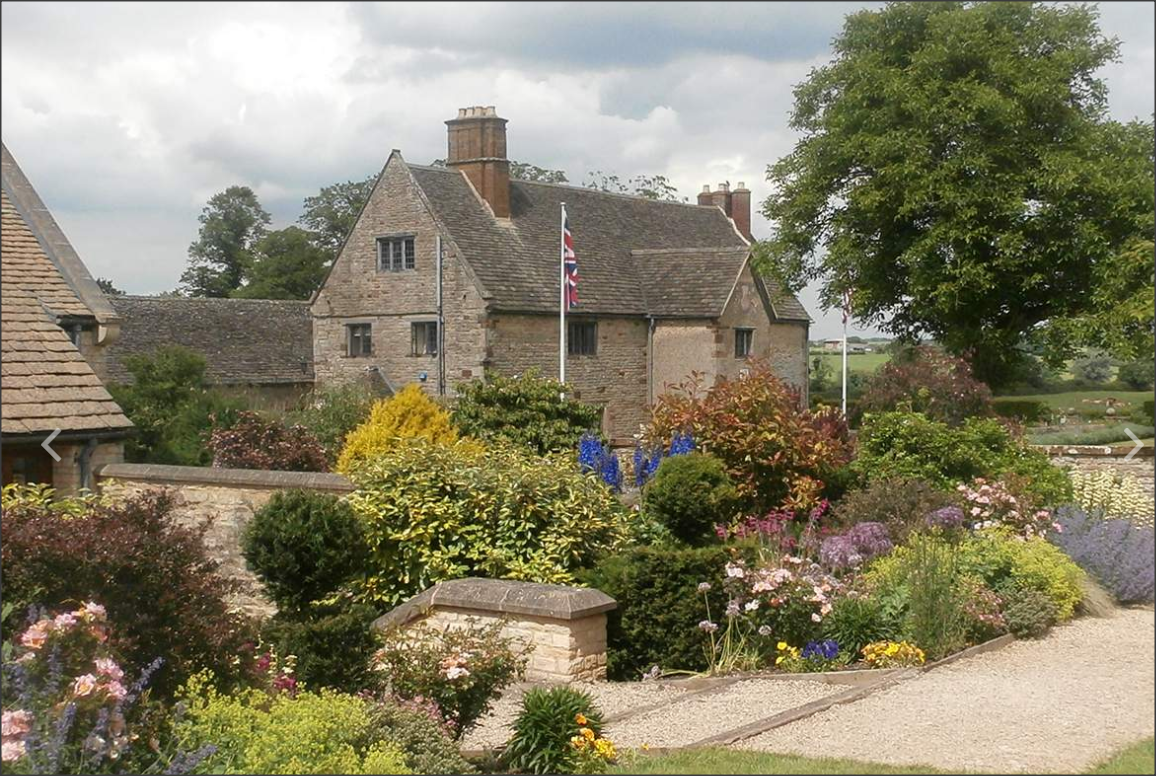 Sulgrave Manor is the ancestral home in England of George Washington's family. The property is situated in the beautiful rural village community of Sulgrave, near to Banbury and about 30 miles from both Stratford-upon-Avon and Oxford. It was bought by Lawrence Washington, a wealthy wool merchant and Mayor of Northampton, when Henry VIII dissolved the monasteries. Lawrence's descendants lived for over 120 years (1539 - 1659) in the home that he built. When the English Civil War between Charles I and Oliver Cromwell's Parliamentary Army broke out, many of Lawrence Washington's descendants supported the Royalist cause. After the defeat of Charles I, many Royalists emigrated to Virginia and in 1656, Colonel John Washington, the great-great grandson of Lawrence Washington and the great-grandfather of George Washington, crossed the Atlantic. More than 250 years after the first Washington's' landed in America, President Theodore Roosevelt decided that there should be a proper celebration of the centenary of the end of the war of 1812 - the last serious armed conflict between England and America. Prominent statesmen and civic leaders were recruited to form peace committees in the United States, in Great Britain and in Canada. The British committee decided to purchase George Washington's ancestral home on behalf of the British and American people and, after World War I, King George V was a leading contributor to the Sulgrave Manor Restoration Fund. The House 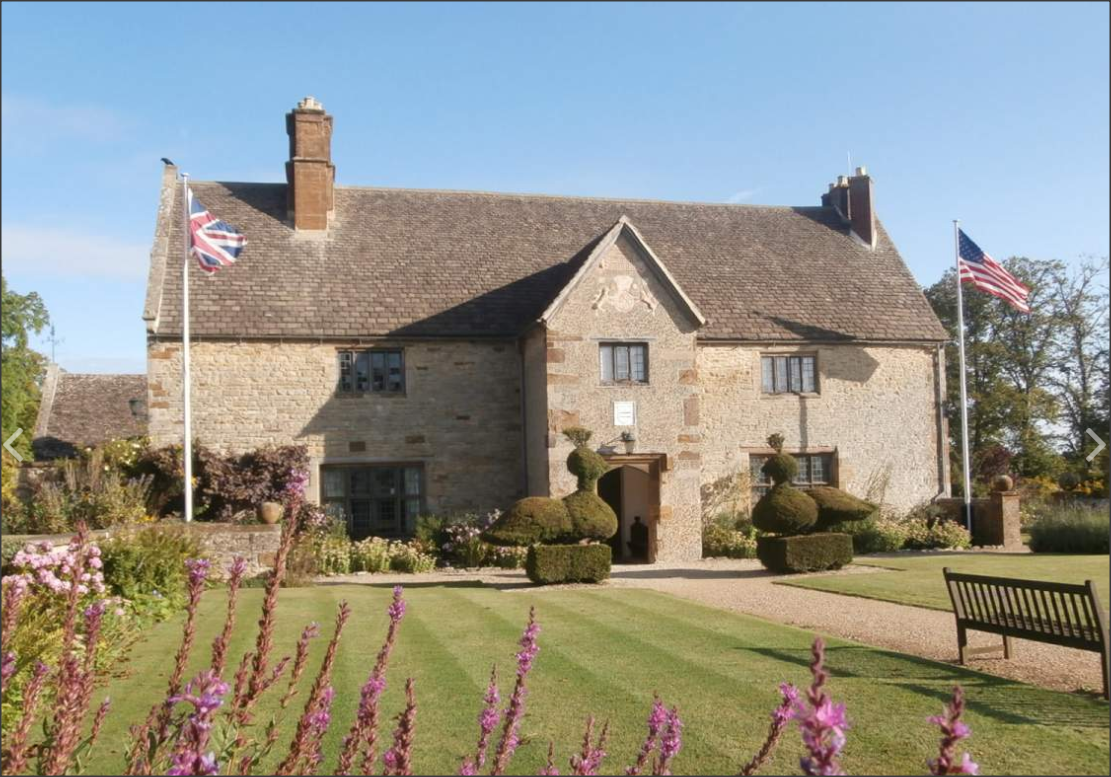 Each room in the house is furnished to suit either the Tudor or the Queen Anne period, and the difference between these two styles is particularly striking when stepping from the stone flagged Tudor Great Hall, to the cozy, wood paneled 18th century parlour. One of the most fascinating rooms is the fully furnished 18th century Kitchen, complete with open hearth and a huge array of pots, pans and other curious equipment. Upstairs, the two 18th century bedrooms are elegantly furnished with exquisitely embroidered bed hangings and period items, such as a spinning wheel, an embroidered waistcoat, shoes and samplers. The third bedroom provides, once again, the contrast created by 200 years of development in comfort, it is the Tudor Great Chamber; a large, high ceiling room with a broad fireplace and sparse furnishing. Beyond this room is a collection of fascinating items relating to the house and its famous connections. Outside the house, the Washington coat of arms, said to have been the inspiration for the American flag, can be seen above the main porch. Gardens 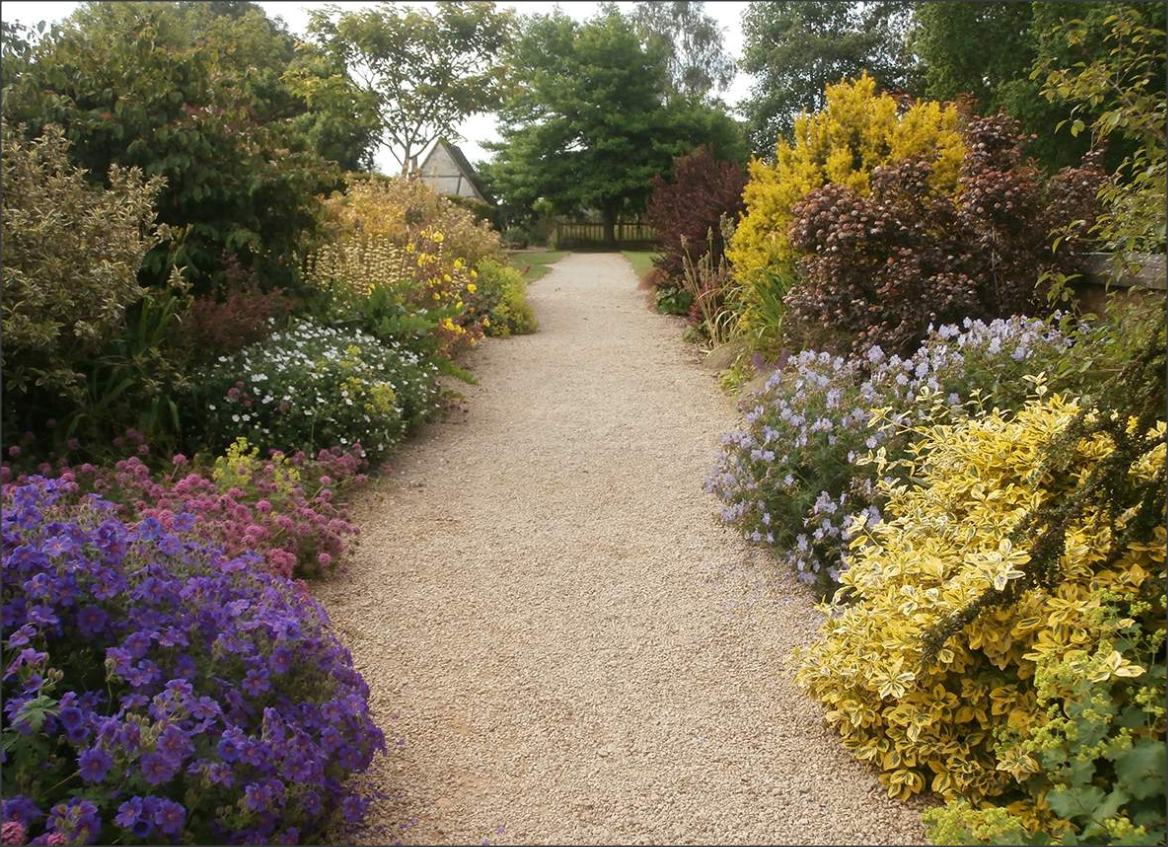 One of the many attractive features of the manor is the garden. To the East is the Rose Garden with its 16th century sundial. Lavender grows in profusion, and many thousands of bags of Sulgrave Lavender have crossed the Atlantic since the house was opened to the public. Beyond a yew hedge is the Kitchen Garden, which would have supplied fresh vegetables for the household. On either side of the porch are herbaceous borders, which in summer are a riot of colour, brimming over with flowers, which threaten to engulf the ground floor window. Stretching southwards is the well kept lawn with its fine topiary work. On the terrace lawn there is a herb garden in the form of an Elizabethan Knot. The Orchard, beyond, is under planted with bulbs, which provide a magnificent display each spring. To the West of the formal gardens is a paddock planted with a variety of trees and shrubs. This affords a fine view of the house and gardens, and is set out with tables and benches for picnicking. |